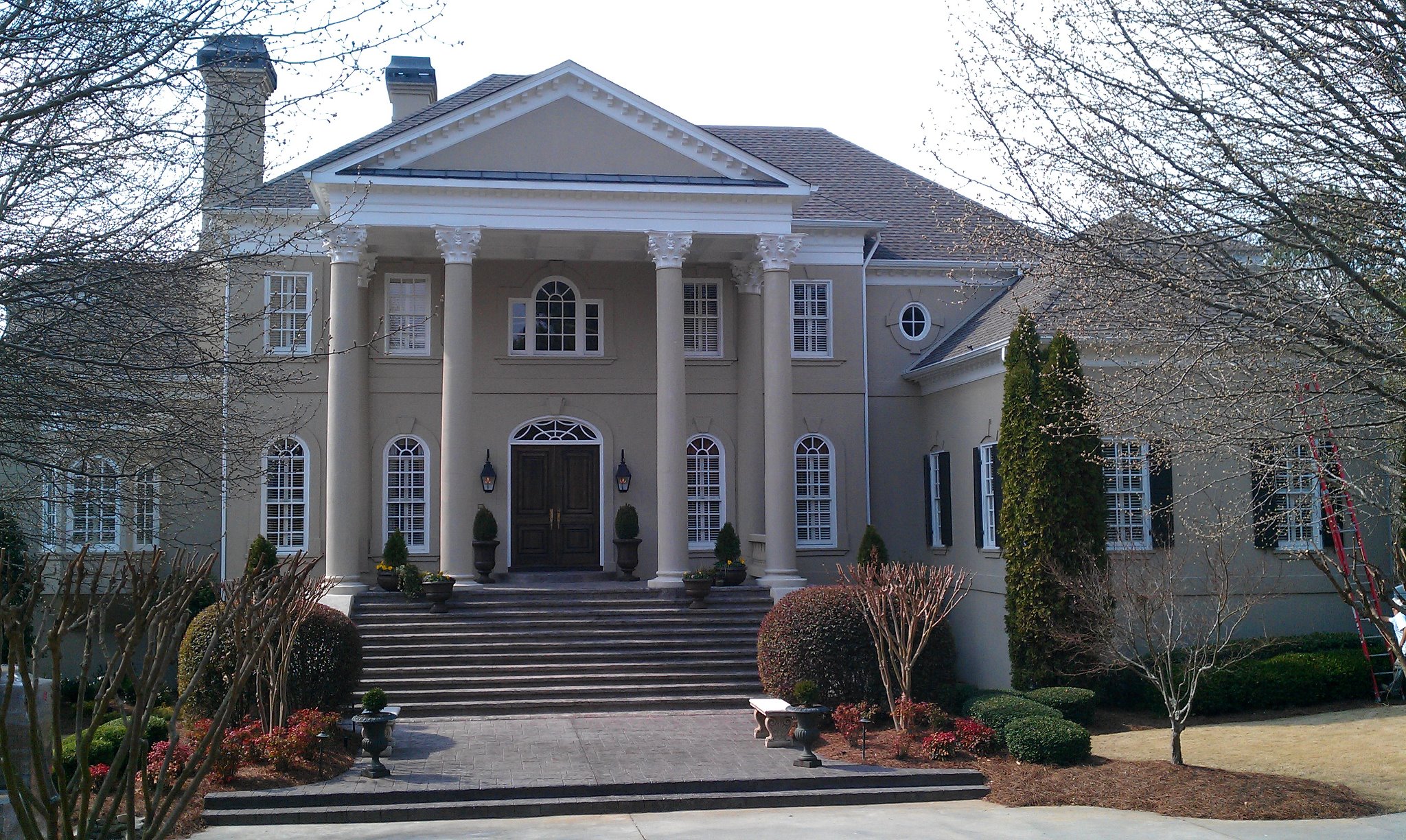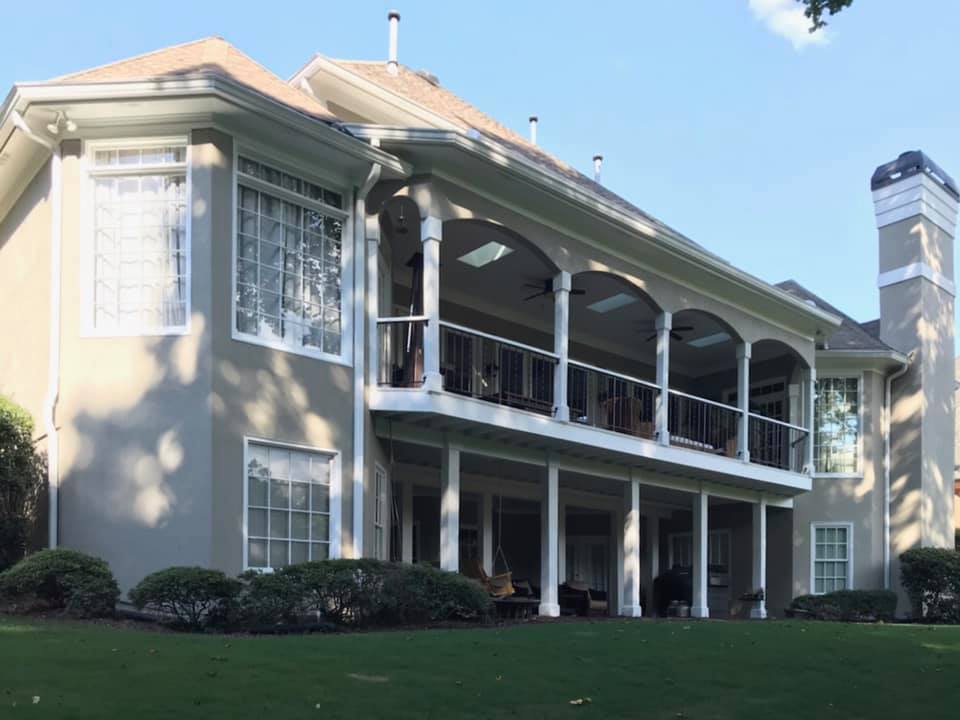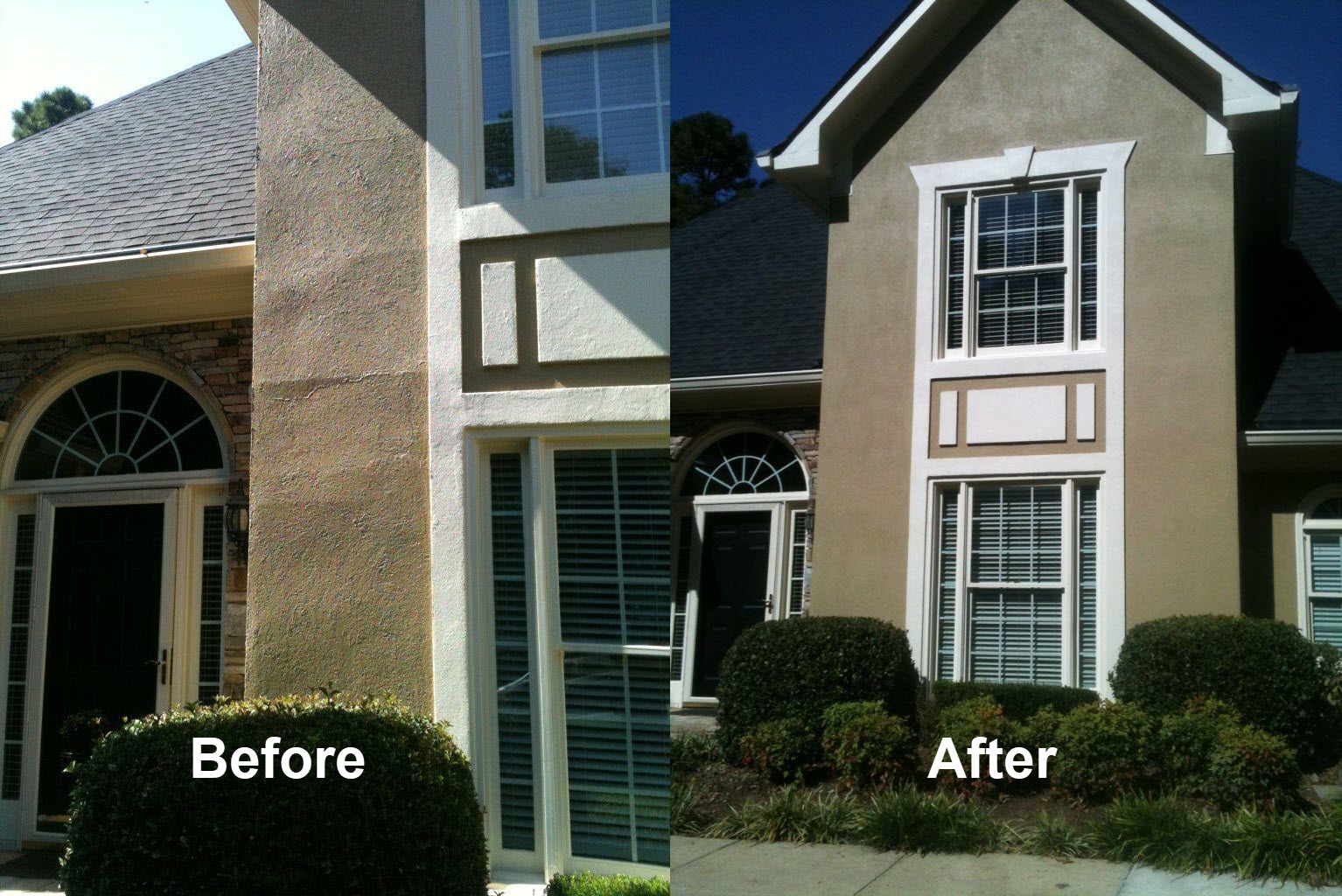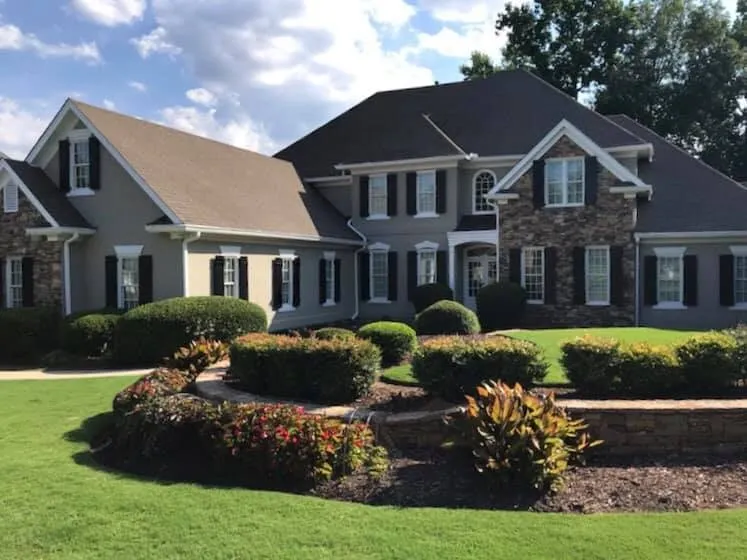Home Stuccoin Ball Ground GA
Home Stucco for Enhanced Aesthetics and Value
We Are Locally Owned & Operated For Over 24 Years
We Serve Businesses In And Around The Following Cities:
About Home Stucco in Ball Ground, Georgia
Comprehensive Guide to Stucco Installation and Repair in Ball Ground, Georgia
Stucco has been a classic choice for property exteriors, renowned for its aesthetic appeal, durability, and cost-effectiveness. In Ball Ground, Georgia, home and business owners increasingly turn to this versatile material for both new installations and repairs. Advanced Stucco Repair offers unparalleled expertise in the installation and repair of stucco, EIFS, and Dryvit systems, catering to both residential and commercial properties. This comprehensive guide delves into the intricacies of stucco work and its real-world applications, conveying valuable insights to help both homeowners and businesses understand why Advanced Stucco Repair is the ideal choice for their needs.
The Art and Science of Stucco Application
The installation of stucco involves both artistic finesse and technical precision. This exterior finish, typically composed of cement, sand, and water, brings a Mediterranean charm that suits various architectural styles. Advanced Stucco Repair begins the process with a thorough assessment of the underlying structure to ensure compatibility and longevity. The aim is to create a flawless base that supports the stucco layer effectively, avoiding future complications.
In Ball Ground and the greater Georgia area, the weather can pose various challenges to stucco exteriors. Temperature fluctuations, precipitation, and humidity require a robust approach to stucco installation. The experts at Advanced Stucco Repair understand how to adapt their technique to these local conditions, ensuring that their work stands the test of time.
Whether it's the conventional three-coat stucco process involving scratch, brown, and finishing coats, or the more modern one-coat stucco systems, each method has its own benefits. The selection of the appropriate method is primarily dictated by the client's desires, architectural design, and the structural specifics of the building. Advanced Stucco Repair prides itself on guiding property owners through these choices, ensuring the balance of form and function in every project.
Understanding EIFS and Dryvit Systems
For those seeking enhanced insulation alongside the aesthetic perks of stucco, Exterior Insulation and Finish Systems (EIFS) are the perfect solution. EIFS, also commonly referred to by the brand name Dryvit, integrates a layer of insulation beneath the finishing coat, offering superior energy efficiency. Given the periodic temperature extremes experienced in Georgia, a well-installed EIFS can significantly reduce energy bills, making it a highly sought-after option for both residential and commercial properties.
Advanced Stucco Repair’s proficiency in EIFS spans not just installation but also intricate repairs. Common issues such as moisture ingress, mechanical damage, or faulty installation can lead to insulation failure. Expert intervention can resolve these, restoring the system’s integrity. The team’s extensive knowledge about the nuances of EIFS ensures lasting solutions that preserve the structure while offering substantial energy savings.
The Benefits of Choosing Stucco
Stucco offers several advantages that make it a preferred choice for many in Ball Ground, Georgia. First and foremost, its fire-resistant properties provide an extra layer of safety, a crucial factor in residential and commercial construction. Additionally, stucco is remarkably low-maintenance, requiring only occasional cleaning to retain its original luster.
Furthermore, its versatility is unmatched. Whether you're aiming for a sleek modern exterior, a rustic finish, or intricate architectural detailing, stucco accommodates a wide range of aesthetic preferences. Color options abound, and the finish can be tailored to reflect the specific style envisioned by the property owner.
Moreover, stucco is also resistant to mold, rot, and pest intrusion, further enhancing its durability in the humid climate of Georgia. This resistance is particularly beneficial for minimizing long-term repair costs, presenting a cost-effective solution over time. Advanced Stucco Repair’s commitment to excellence ensures that each stucco application achieves these benefits, providing both beauty and protection to the property.
Repair and Maintenance of Stucco Systems
Despite its durability, stucco may require repairs over time due to environmental stressors, accidental impacts, or underlying movement in the building’s structure. Identifying these issues early is crucial to prevent more extensive damage. Common signs include cracking, discoloration, or bulging of stucco surfaces. When such signs are observed, contacting a professional early can forestall further deterioration.
Advanced Stucco Repair offers comprehensive repair solutions tailored to each situation. The team conducts a meticulous inspection to diagnose underlying issues, addressing both the surface problem and its root cause. Whether it's a simple patch repair, a reapplication, or a complete overhaul, they ensure that repairs blend seamlessly with the existing structure to maintain a consistent appearance.
Beyond repairs, ongoing maintenance is another area where Advanced Stucco Repair excels. Scheduled inspections and touch-ups can extend the lifespan of stucco exteriors, preserving their appearance and functionality. This proactive approach aligns with the philosophy of preventive care, ensuring the long-term satisfaction of their clients.
Commercial Applications and Business Benefits
For businesses in Ball Ground, the exterior of a building can be a vital component of its branding and customer perception. A well-maintained stucco exterior projects professionalism, quality, and attention to detail. In the competitive commercial environment of Georgia, these factors can significantly influence client decisions.
Advanced Stucco Repair’s expertise extends across various commercial applications, from retail facades to office complexes and hospitality venues. Their team understands the unique requirements of commercial projects, ensuring minimal disruption to business operations during installations or repairs.
Moreover, the choice of materials used in commercial applications often considers the high traffic and usage demands typical of such settings. Advanced Stucco Repair employs materials and techniques that withstand these conditions, optimizing durability while enhancing the building’s aesthetic appeal. The integration of EIFS in commercial settings not only improves energy efficiency but also contributes to sustainability goals, which many businesses prioritize today.
Real-World Examples of Stucco Solutions in Ball Ground
The practical applications of Advanced Stucco Repair’s services are best illustrated through real-world examples across Ball Ground, Georgia. Residential properties, whether modern or traditional, benefit from expertly applied stucco, reflecting the personal tastes of homeowners while providing unmatched protection. Take, for instance, a local family who transformed a dated facade into a modern masterpiece with a sleek stucco finish, significantly enhancing their home's curb appeal.
On the commercial front, an office building in a bustling district of Ball Ground experienced a complete stucco restoration and EIFS upgrade. The transformation not only improved the building's energy performance but also reinvigorated its exterior presence, making it a standout structure in the area. These examples demonstrate the tangible impacts of quality stucco work, leading to satisfied clients and sustainable building practices.
These services are not limited to new applications but extend to restoring older stucco systems to their former glory. Buildings that might otherwise undergo costly exterior overhauls find new life through Advanced Stucco Repair’s innovative solutions, reinforcing faith in this time-honored material and its modern adaptations.
If you're in Ball Ground and contemplating a stucco project for your home or business, it’s worth considering a consultation with Advanced Stucco Repair. Their extensive experience and commitment to quality assure that your property will receive the care and attention it deserves, ensuring lasting beauty and efficiency.
The journey into the world of stucco solutions highlights its multifaceted benefits and applications. As property owners increasingly seek durable and aesthetic exterior solutions, stucco remains a top contender. Advanced Stucco Repair stands as a beacon of trust and expertise, providing services that are a testament to quality and precision.
In every project, whether it's enhancing a home's exterior or revitalizing a business facade, the team's dedication to excellence assures client satisfaction and superior outcomes. When the need for stucco installation or repair arises, entrusting the task to professionals like Advanced Stucco Repair ensures a seamless experience and results that speak volumes about the enduring appeal of this timeless finishing method.
Home Stucco Gallery



Call Us Today to receive your Free Quote for
Home Stucco in Ball Ground
Serving: Ball Ground, Georgia

About Ball Ground, Georgia
The area that encompasses Ball Ground was originally inhabited by both the Cherokee and the Muscogee Creek, until the Battle of Taliwa, which took place in what later became Ball Ground in 1755, between the Cherokee and the Muscogee Creek, ending with a Cherokee victory and forcing the Creek out of the territory.
Following the passing of the Indian Removal Act in 1830, the Cherokee were slowly relocated out of Cherokee County, including the Ball Ground area. The area of Ball Ground and the surrounding Cherokee County was distributed to European-Americans via the 1832 Georgia Land Lotteries, though the lands were not settled by them until the 1835 Treaty of New Echota caused the Cherokee to fully leave North Georgia and relocate west of the Mississippi River as part of the Cherokee removal out of North Georgia.
The name Ball Ground was initially given by settlers to refer to an area of land, not for the town or community. Native Americans would use the area as a ballground to play a game similar to town ball, and settlers named the town Ball Ground in reference to this. Over time details were added to the story of why the town was named Ball Ground. One such story was that the site was so named because it was the location of a 1532 game of ball between Native Americans playing against Hernando de Soto and his men, in a game umpired by the owner of the Fountain of Youth. When a fight broke out during the game, the umpire was killed, taking the secret of the location of the Fountain of Youth with him. Another story attested as "local folklore" by the Cherokee County Chamber of Commerce says that the site is named Ball Ground because of a game of stickball played between the Cherokee and Creek "for the prize of a thousand square miles of land".
After acquisition from the Cherokee in the 1830s, Ball Ground was originally settled as farmland and had few people living in the area. By 1847, the Ball Ground area had a post office, which was one of ten post offices within Cherokee County. In 1882, just before the town was established, Ball Ground had six homes and two country stores.
Meetings were held in 1875 in various areas including Ball Ground to discuss the possibility of a railroad being built through Ball Ground and other nearby areas. In 1881 work began on a railroad to Ball Ground using chain gangs for labor and grading on the railroad's path was completed in Ball Ground that same year. The resulting track was part of the Marietta and North Georgia Railroad and was completed in 1882. Upon completion the terminus of the railroad was the newly constructed depot in Ball Ground.
A town was built around the Ball Ground depot using surrounding land that was donated by thirteen nearby landowners for the express purpose of establishing a town. The deed of transfer to the railroad company noted that “The consideration moving each of us in the establishing of this town is the enhanced value to our lands within and adjacent to the said town, and the general benefit to the country, by which we shall be benefited.” The donated land was split into 200 lots and sold via an auction held in Ball Ground on April 18, 1883, along with other additional properties including a 65 acres (26 ha; 0.102 sq mi) farm and a nearby mill. The next year in 1884, the town had approximately 300 residents.
Ball Ground was incorporated as a town by town charter on September 27, 1883, by an act of the Georgia General Assembly. The town limits were set as "one half mile in every direction from the present railroad crossing on the Gilmer Ferry road; that it shall be known and distinguished as the town of Ball Ground."
In January 1896 a judge approved the sale of the Marietta and North Georgia railroad to the Atlanta, Knoxville, and Northern railway due to nonpayment of loans by the former railroad. The property to be sold included the depots along the railroad route which included the Ball Ground depot. The plaintiffs in the case were those owed money by the railroad and gave loans that were taken out to charter the railroad, but the scheduled April 1896 sale of the railroad was subsequently delayed through the courts by order of the same judge that initially approved the sale. That same month the Marietta and North Georgia railroad missed their payment deadline and the sale moved forward. On November 1, 1896, the Marietta and North Georgia Railroad was purchased by and turned over to the Atlanta, Knoxville, and Northern railway. Atlanta, Knoxville, and Northern was sold to the Louisville and Nashville Railroad in 1902.
An amendment to the town's charter was passed in 1903 to change the election times, clarifying the issuance of liquor licenses and set a price for said license at "not less than $500". The amendment also clarified how ad valorem taxes were to be collected. A further amendment in 1905 changed the 1903 amendment's $500 liquor license fee to $5,000. An updated charter passed by an act of the Georgia General Assembly in 1911 greatly expanded the powers of the municipal government, including the ability to pass municipal ordinances, and established a school district within Ball Ground.
In 1961 a Ball Ground Improvement Association was formed to add improvements to the city including new paint, a city park, and street lights.
A television documentary aired in December 1971 on North Georgia's Channel 11 that focused on the city of Ball Ground and described it as a city in decline, and interviewed Ball Grounders about "the slow deterioration of the town." Two weeks after the broadcast of the documentary, the city's merchants announced that they had organized the Ball Ground Merchants Association to promote trade and to function as a Chamber of Commerce for the city.
The Ball Ground Community Association was formed in early 1972 to promote the town and to organize festivals and cultural events. The first event the association organized was the May 1972 spring festival and parade, which included a delegation from the Cherokee Nation. This marked the first time the Cherokee returned to the area in any official capacity since they were removed from the area during the 1830s. As part of the festival, two Cherokee teams played a game of stickball against one another, and then-Lieutenant Governor Lester Maddox served as the parade's grand marshal. Later that year in November 1972, in part because of the festival and other improvements to the city, Ball Ground won the "1972 Stay & See Georgia" contest, which was a program designed to help highlight and expand tourism within the State of Georgia. The spring festival was held annually until 1989.
In 1997 developers began building new homes and communities within Ball Ground. Because of the growth of the city, residents and city officials began discussing the need for an improved sewer system to help modernize the septic systems of older homes and to attract new growth for the city.
In 1998 a plan was put in place to begin work on a $2.8 million sewage system. The sewage system was completed in Fall 2003 amid ongoing development in and around Ball Ground.
Ball Ground is located at the foothills of the North Georgia mountains in the northeastern portion of Cherokee County. The city is 4.7 mi (7.6 km) northeast of the city of Canton and 0.4 mi (0.64 km) south of Nelson. It is the northernmost city in Cherokee County that is fully within the county limits, as the city of Nelson is partially within Pickens County. Ball Ground is 37.9 mi (61 km) north of Georgia's capital city of Atlanta's northernmost city limits and 48.7 mi (78 km) from downtown Atlanta.
Ball Ground lies within the Upper Piedmont Physiographic Province in a narrow band of land called the Hightower-Jasper Ridge District, which has a different land structure and lithology than the surrounding areas. The bedrock underneath the city consists of igneous and metamorphic rocks such as gneiss and schist. The land in and around Ball Ground is rich in marble deposits as well as talc, pyrite, and gold.
According to the United States Census Bureau as of 2020, Ball Ground has a total area of 6.3 sq mi (16 km), of which 0.04 sq mi (0.10 km), or 0.63%, is water. The city's elevation averages around 1,100 ft (340 m) above sea level, ranging from just over 1,000 ft (300 m) in the valleys to around 1,200 ft (370 m) on several hilltops within the city. Unlike most other parts of Cherokee County, Ball Ground is not in a floodplain and has no typically flood prone areas. To protect the water and surrounding lands, the city government has ordinances in place for stream buffer protection, watershed protection, and wetland protection.
The climate of Ball Ground, as with most of the southeastern United States, is humid subtropical (Cfa) according to the Köppen classification, with four seasons including hot, humid summers and cool winters. July and August are generally the warmest months of the year with an average high of around 85 °F (29 °C). The coldest month is January which has an average high of around 48 °F (9 °C).
Ball Ground receives rainfall distributed fairly evenly throughout the year as typical of southeastern U.S. cities, with March on average having the highest average precipitation at 5.15 in (131 mm), and May typically being the driest month with 3.81 in (97 mm).
| Census | Pop. | Note | %± |
|---|---|---|---|
| 1890 | 296 | — | |
| 1900 | 302 | 2.0% | |
| 1910 | 443 | 46.7% | |
| 1920 | 809 | 82.6% | |
| 1930 | 706 | −12.7% | |
| 1940 | 711 | 0.7% | |
| 1950 | 700 | −1.5% | |
| 1960 | 707 | 1.0% | |
| 1970 | 617 | −12.7% | |
| 1980 | 640 | 3.7% | |
| 1990 | 905 | 41.4% | |
| 2000 | 730 | −19.3% | |
| 2010 | 1,433 | 96.3% | |
| 2020 | 2,560 | 78.6% | |
| 2023 (est.) | 3,039 | 18.7% | |
| U.S. Decennial Census | |||
The results of the 2000 United States census showed that Ball Ground had shrunk in population in the previous ten years, going from a population of 905 in 1990 to 730 in 2000. After the improvements to the sewage infrastructure and the development of homes and businesses in and around Ball Ground in the 2000s, the city began to see large amounts of growth. During the 2010 census the population had grown 96.3% to 1,433, and in 2020 had grown an additional 78.6% to 2,560.
As of the 2020 United States census, there were 2,560 people, 838 households, and 626 families residing in the city. The population density was 406.3/sq mi (156.9/km).
According to the 2020 American Community Survey, there were 838 households, out of which 33.8% had children under the age of 18 living with them, 67.1% were married couples living together, 1.2% had a male householder with no spouse present, 7% had a female householder with no spouse present, and 24.7% were non-families. 17.8% of all households were made up of individuals, and 3.6% had someone living alone who was 65 years of age or older. The average household size was 2.66 and the average family size was 3.03.
In the city, the population was spread out, with 22.7% under the age of 18, 6.8% from 18 to 24, 27.3% from 25 to 44, 32.2% from 45 to 64, and 11.1% who were 65 years of age or older. The median age was 38.4 years. For every 100 females, there were 108.4 males. For every 100 females age 18 and over, there were 110 males.
The median income for a household in the city was $81,900, and the median income for a family was $92,690. Males had a median income of $51,393 versus $40,893 for females. The per capita income for the city was $18,147. About 4% of the population was below the poverty line, including 6.2% of those under age 18 and 0.8% of those age 65 or over.
| Race | Num. | Perc. |
|---|---|---|
| White (non-Hispanic) | 2,300 | 89.84% |
| Black or African American (non-Hispanic) | 21 | 0.82% |
| Native American | 7 | 0.27% |
| Asian | 6 | 0.23% |
| Other/Mixed | 104 | 4.06% |
| Hispanic or Latino | 122 | 4.77% |
Since the incorporation of the town in 1883, the city has been managed by a mayor and city council consisting of five council-members, which meet on the second Thursday of each month. The city government also consists of a city clerk, city attorney, and a city manager.
The city has a municipal court which is held on the third Friday of each month. With the exception of a small police department managed by the city, most services are provided by Cherokee County, including animal control, building inspections, planning and zoning, parks and recreation, and jail operations. Cherokee County Fire Department is responsible for fire protection in Ball Ground, and Cherokee County Fire Station #2 is located in Ball Ground.
In the United States House of Representatives, Ball Ground is split between Georgia's 9th congressional district and Georgia's 11th congressional district. For representation in the state government, Ball Ground is part of the Georgia State Senate's 21st district, and the 22nd district for the Georgia House of Representatives.
Public education for students in Ball Ground is administrated by the Cherokee County School District and students within the city attend Ball Ground Elementary School, Creekland Middle School, and Creekview High School. High School students in Ball Ground also have the option of attending Mountain Education Charter High School (MECHS), an alternative school program that offers evening classes for obtaining a high school diploma. While MECHS has eighteen campuses throughout the North Georgia area, the Cherokee County classes of MECHS are held at the Etowah High School campus in Woodstock, Georgia.
TLE Christian Academy at Gospel Outreach Inc is the only private school in Ball Ground and is a private K-12 school with a 2021 enrollment of 30 students.
The nearest college or university to Ball Ground is Reinhardt University in Waleska, Georgia in Cherokee County, 12.1 mi (19.5 km) from Ball Ground.
